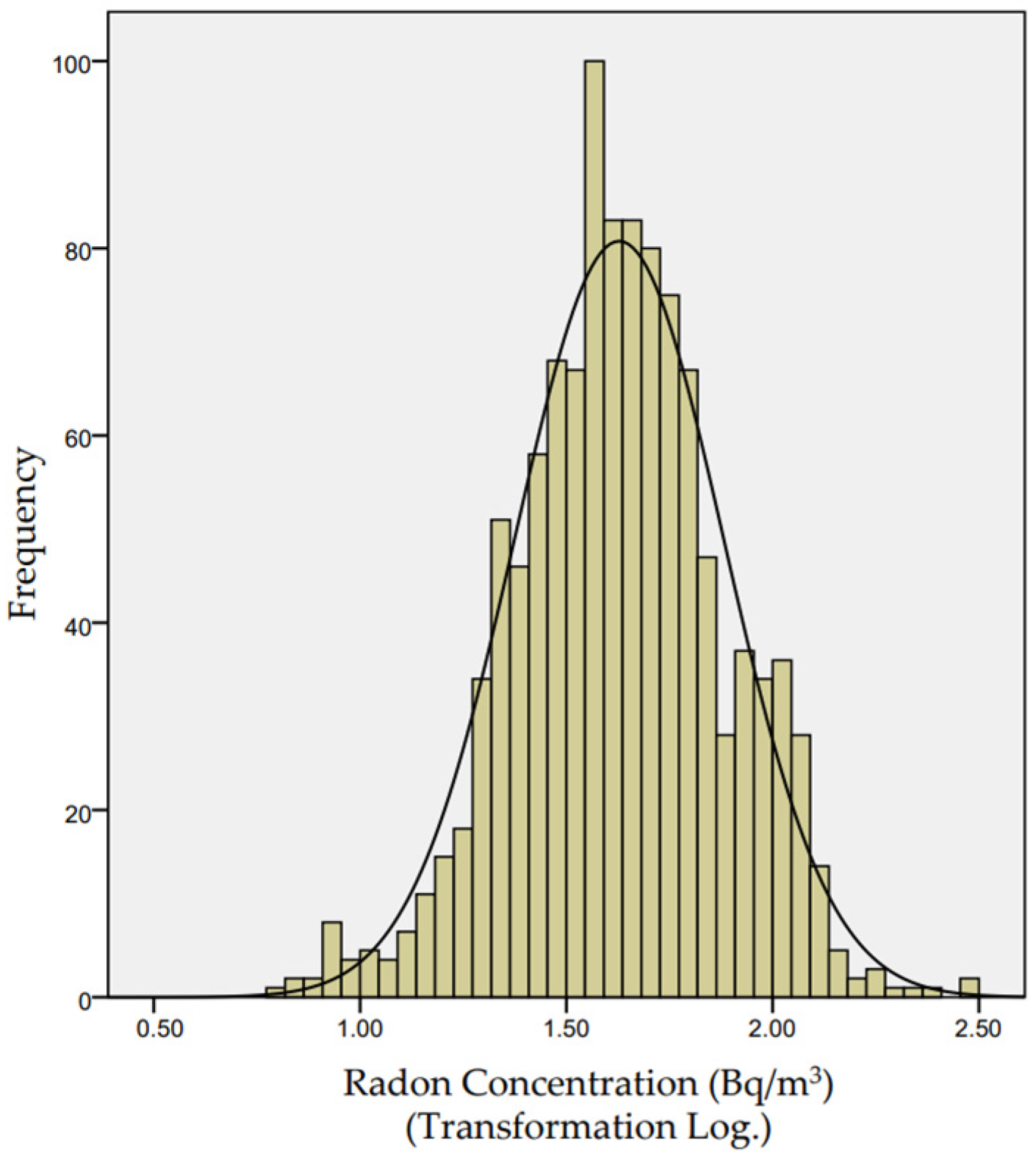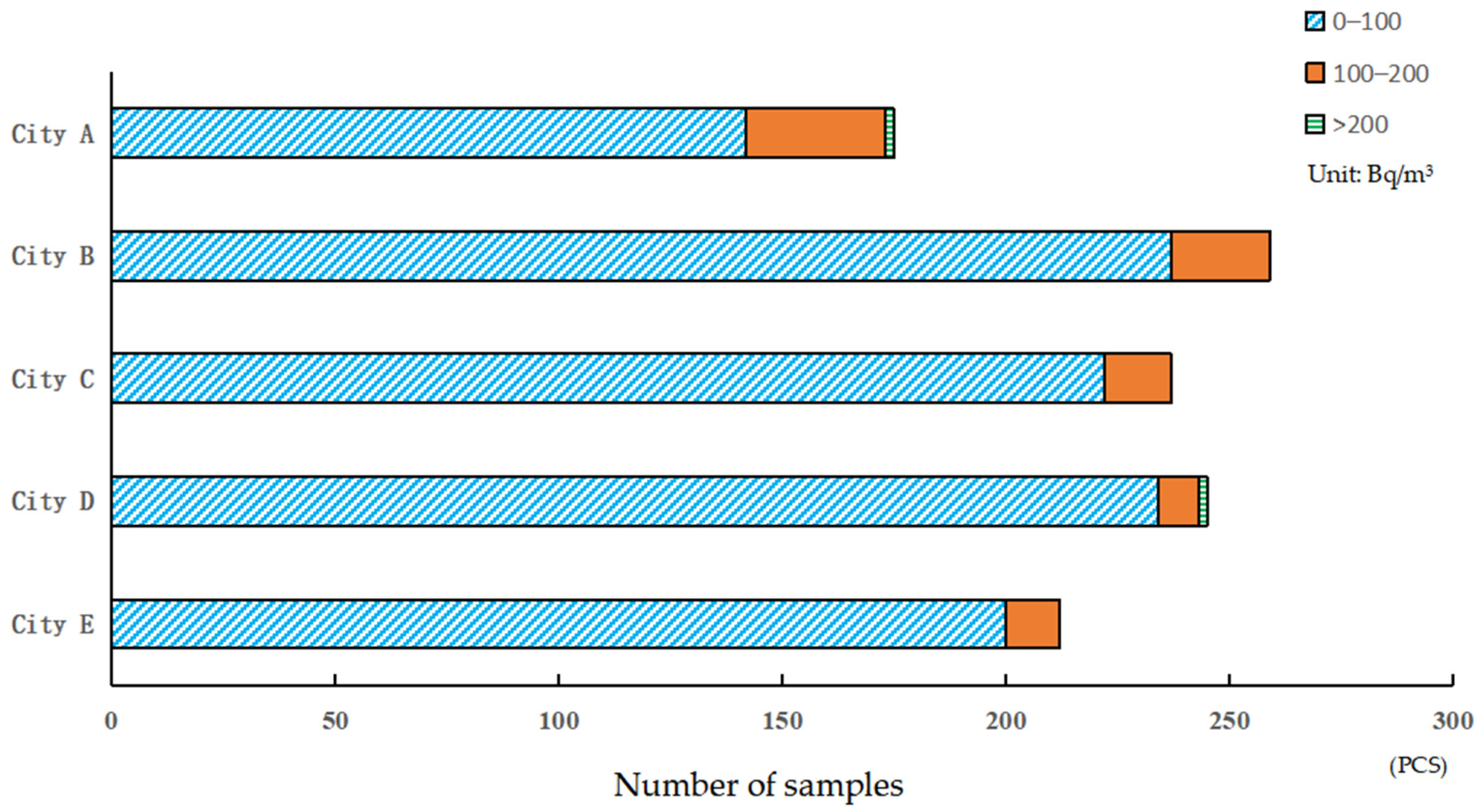Investigation and Analysis of Indoor Radon Concentrations in Typical Residential Areas in Central China
Abstract
1. Introduction
2. Materials and Methods
2.1. Radon Measurement
2.1.1. Measuring Instruments and Materials
2.1.2. Detector Reading
2.2. Investigation Plan
2.2.1. Monitoring Location
2.2.2. Monitoring Time and Sampling Methodology
2.2.3. Detector Placement and Questionnaire Survey
2.3. Estimation of Public Effective Dose
2.4. Statistical Analysis
3. Results
3.1. Detector Configuration
3.2. Indoor Radon Levels in Central China
Residential Radon Levels Across Various Geographical Locations in Central China
3.3. Correlation Analysis and Multiple Linear Regression Analysis
3.3.1. Correlation Analysis
3.3.2. Multiple Linear Regression Analysis
3.4. Estimation of Public Effective Dose
4. Discussion
5. Conclusions
Author Contributions
Funding
Institutional Review Board Statement
Informed Consent Statement
Data Availability Statement
Acknowledgments
Conflicts of Interest
References
- Charles, M. Effects of Ionizing Radiation: United Nations Scientific Committee on the Effects of Atomic Radiation: UNSCEAR 2006 Report, Volume 1—Report to the General Assembly, with Scientific Annexes A and B; United Nations Office at Vienna: Vienna, Austria, 2010.
- Little, M.; Wakeford, R. Annex A: Epidemiological Studies of Radiation and Cancer; United Nations: New York, NY, USA, 2008.
- Kang, J.-K.; Seo, S.; Jin, Y.W. Health effects of radon exposure. Yonsei Med. J. 2019, 60, 597–603. [Google Scholar] [CrossRef] [PubMed]
- Shahbazi-Gahrouei, D.; Gholami, M.; Setayandeh, S. A review on natural background radiation. Adv. Biomed. Res. 2013, 2, 65. [Google Scholar] [CrossRef] [PubMed]
- International Agency for Research on Cancer. Man-Made Mineral Fibres and Radon; IARC Monographs on the Evaluat: Lyon, France, 1988; Volume 43. [Google Scholar]
- World Health Organization. WHO Handbook on Indoor Radon: A Public Health Perspective; World Health Organization: Geneva, Switzerland, 2009.
- Pawel, D.; Puskin, J. The US Environmental Protection Agency’s assessment of risks from indoor radon. Health Phys. 2004, 87, 68–74. [Google Scholar] [CrossRef] [PubMed]
- Zielinski, J.M.; Carr, Z.; Krewski, D.; Repacholi, M. World health organization’s international radon project. J. Toxicol. Environ. Health Part A 2006, 69, 759–769. [Google Scholar] [CrossRef] [PubMed]
- Li, C.; Wang, C.; Yu, J.; Fan, Y.; Liu, D.; Zhou, W.; Shi, T. Residential radon and histological types of lung cancer: A meta-analysis of case–control studies. Int. J. Environ. Res. Public Health 2020, 17, 1457. [Google Scholar] [CrossRef] [PubMed]
- López-Abente, G.; Núñez, O.; Fernández-Navarro, P.; Barros-Dios, J.M.; Martín-Méndez, I.; Bel-Lan, A.; Locutura, J.; Quindós, L.; Sainz, C.; Ruano-Ravina, A. Residential radon and cancer mortality in Galicia, Spain. Sci. Total Environ. 2018, 610, 1125–1132. [Google Scholar] [CrossRef] [PubMed]
- Bruno, R.C. Sources of indoor radon in houses: A review. J. Air Pollut. Control Assoc. 1983, 33, 105–109. [Google Scholar] [CrossRef]
- Sakoda, A.; Ishimori, Y.; Hasan, M.M.; Jin, Q.; Iimoto, T. Seasonal Variations in Radon and Thoron Exhalation Rates from Solid Concrete Interior Walls Observed Using In Situ Measurements. Atmosphere 2024, 15, 701. [Google Scholar] [CrossRef]
- Ivanova, K.; Stojanovska, Z.; Kunovska, B.; Chobanova, N.; Badulin, V.; Benderev, A. Analysis of the spatial variation of indoor radon concentrations (national survey in Bulgaria). Environ. Sci. Pollut. Res. 2019, 26, 6971–6979. [Google Scholar] [CrossRef] [PubMed]
- Gulan, L. Analysis of Long-Term Monitoring of Radon Levels in a Low-Ventilated, Semi-Underground Laboratory—Dose Estimation and Exploration of Potential Earthquake Precursors. Atmosphere 2024, 15, 1534. [Google Scholar] [CrossRef]
- Park, T.H.; Kang, D.R.; Park, S.H.; Yoon, D.K.; Lee, C.M. Indoor radon concentration in Korea residential environments. Environ. Sci. Pollut. Res. 2018, 25, 12678–12685. [Google Scholar] [CrossRef] [PubMed]
- Zuhong, H.; Xiangjun, Y.; Jun, Q. Investigation and Control of Indoor Radioactivity Levels in Wuhan City. J. Public Health Prev. Med. 2005, 16, 2. [Google Scholar]
- Janik, M.; Hasan, M.M.; Bossew, P.; Kavasi, N. Effects of storage time and pre-etching treatment of CR-39 detectors on their response to alpha radiation exposure. Int. J. Environ. Res. Public Health 2021, 18, 8346. [Google Scholar] [CrossRef] [PubMed]
- George, A. The history, development and the present status of the radon measurement programme in the United States of America. Radiat. Prot. Dosim. 2015, 167, 8–14. [Google Scholar] [CrossRef] [PubMed]
- GB/T 16146-2015; Requirements for Control of Indoor Radon and Its Progeny. General Administration of Quality Supervision, Standardization Administration of the People’s Republic of China: Beijing, China, 2016.
- US Environmental Protection Agency, Indoor Environments Division. A Citizen’s Guide to Radon: The Guide to Protecting Yourself and Your Family from Radon; US Environmental Protection Agency, Indoor Environments Division: Washington, DC, USA, 2002.
- Barros-Dios, J.; Ruano-Ravina, A.; Gastelu-Iturri, J.; Figueiras, A. Factors underlying residential radon concentration: Results from Galicia, Spain. Environ. Res. 2007, 103, 185–190. [Google Scholar] [CrossRef] [PubMed]
- Nikolopoulos, D.; Kottou, S.; Louizi, A.; Petraki, E.; Vogiannis, E.; Yannakopoulos, P. Factors affecting indoor radon concentrations of Greek dwellings through multivariate statistics-first approach. J. Phys. Chem. Biophys. 2014, 4, 145. [Google Scholar] [CrossRef]
- Kropat, G.; Bochud, F.; Jaboyedoff, M.; Laedermann, J.-P.; Murith, C.; Palacios, M.; Baechler, S. Predictive analysis and mapping of indoor radon concentrations in a complex environment using kernel estimation: An application to Switzerland. Sci. Total Environ. 2015, 505, 137–148. [Google Scholar] [CrossRef] [PubMed]
- Atik, S.; Yetis, H.; Denizli, H.; Evrendilek, F. Monitoring spatiotemporal dynamics of indoor radon concentration in the built environment of a university campus. Fresenius Env. Bull 2016, 25, 823–829. [Google Scholar]



| Batch | Laying Time | Number of Detectors (Parallel Samples) |
|---|---|---|
| First batch | April 2019–July 2019 | 651 (65) |
| Second batch | July 2019–October 2019 | 649 (70) |
| Total | April 2019–October 2019 | 1300 (135) |
| Laying Time | Min | Max | GM | GSD | M (P25, P75) |
|---|---|---|---|---|---|
| 2019.04–2019.07 | 8.12 | 310.44 | 45.24 | 1.77 | 41.06 (30.20, 66.71) |
| 2019.07–2019.10 | 6.25 | 289.64 | 39.69 | 1.80 | 43.09 (27.62, 59.75) |
| Total | 6.25 | 310.44 | 42.45 | 1.79 | 42.23 (29.03, 61.58) |
| Geographical Position | N(PCs.) | Min | Max | GM * | GSD | M (P25, P75) |
|---|---|---|---|---|---|---|
| City A | 175 | 15.22 | 310.44 | 44.30 a | 1.97 | 38.58 (25.25, 76.36) |
| City B | 259 | 6.58 | 192.56 | 51.47 b | 1.76 | 53.97 (44.08, 70.61) |
| City C | 237 | 6.25 | 144.60 | 34.30 c | 1.79 | 31.51 (23.61, 47.20) |
| City D | 245 | 10.37 | 289.64 | 41.36 a | 1.62 | 39.10 (30.44, 55.55) |
| City E | 212 | 8.12 | 179.32 | 42.35 a | 1.73 | 41.91 (31.25, 59.99) |
| Variable Name | Variable Code | Dummy Variable | Assignment |
|---|---|---|---|
| - | Y | Ln (radon concentration) | |
| Laying time | X1 | From April to July = 0, From July to October = 1 | |
| Geographical location | X2 | X2-1 City A | City A = 1, non-City A = 0 |
| X2-2 City B | City B = 1, non-City B = 0 | ||
| X2-3 City C | City C = 1, non-City C = 0 | ||
| X2-4 City D | City D = 1, non-City D = 0 | ||
| X2-5 City E | City E = 1, non-City E = 0 | ||
| Building structure | X3 | X3-1 reinforced concrete structure | Reinforced concrete structure = 1, nonreinforced concrete structure = 0 |
| X3-2 brick-and-concrete structure | Brick-and-concrete structure = 1, non-brick-and-concrete structure = 0 | ||
| X3-3 brick, wood, or civil structure | Brick, wood, or civil structure = 1, non-brick, wood, or civil structure = 0 | ||
| Ground materials | X4 | X4-1 solid wood flooring | Solid wood flooring = 1, non-solid wood flooring = 0 |
| X4-2 composite floor | Composite floor = 1, non-composite floor = 0 | ||
| X4-3 ceramic tile | Ceramic tile=1, non-ceramic tile = 0 | ||
| X4-4 marble or cement | Marble or cement = 1, non-marble or cement = 0 | ||
| Household fuel | X5 | X5-1 natural gas | Natural gas = 1, non-natural gas = 0 |
| X5-2 liquefied petroleum gas | Liquefied petroleum gas = 1, non-liquefied petroleum gas = 0 | ||
| X5-3 coal or firewood | Coal or firewood = 1, non-coal or firewood = 0 | ||
| Main ventilation mode | X6 | Natural ventilation = 1, alternative ventilation methods = 0 |
| Variable | Non-Standardized Coefficient | Standard Regression Coefficient | t Value | p Value | 95% Confidence Interval of the Regression Coefficient | ||
|---|---|---|---|---|---|---|---|
| Regression Coefficient | Standard Error | Lower Limit | Upper Limit | ||||
| Constant | 3.83 | 0.06 | 66.95 | 0.00 | 3.72 | 3.94 | |
| Laying time | −0.13 | 0.03 | −0.11 | −3.85 | 0.00 | −0.19 | −0.06 |
| City B (VS City A) | 0.08 | 0.06 | 0.06 | 1.41 | 0.16 | −0.03 | 0.20 |
| City C (VS City A) | −0.29 | 0.06 | −0.20 | −5.20 | 0.00 | −0.40 | −0.18 |
| City D (VS City A) | −0.11 | 0.06 | −0.08 | −1.90 | 0.06 | −0.23 | 0.00 |
| City E (VS City A) | −0.09 | 0.06 | −0.06 | −1.54 | 0.12 | −0.21 | 0.03 |
| Brick-and-concrete structure (VS Reinforced concrete structure) | 0.05 | 0.04 | 0.04 | 1.17 | 0.24 | −0.03 | 0.14 |
| Brick, wood, or civil structure (VS Reinforced concrete structure) | 0.21 | 0.08 | 0.13 | 2.74 | 0.01 | 0.06 | 0.35 |
| Composite floor (VS solid wood flooring) | −0.03 | 0.05 | −0.02 | −0.60 | 0.55 | −0.12 | 0.06 |
| Ceramic tile (VS solid wood flooring) | 0.02 | 0.05 | 0.01 | 0.38 | 0.70 | −0.08 | 0.13 |
| Marble or cement (VS solid wood flooring) | 0.05 | 0.06 | 0.04 | 0.80 | 0.42 | −0.07 | 0.17 |
| Liquefied petroleum gas (VS natural gas) | −0.06 | 0.07 | −0.03 | −0.88 | 0.38 | −0.19 | 0.07 |
| Coal or firewood (VS natural gas) | 0.07 | 0.09 | 0.04 | 0.85 | 0.40 | −0.10 | 0.24 |
| Main ventilation mode | 0.23 | 0.09 | 0.07 | 2.49 | 0.01 | 0.05 | 0.40 |
Disclaimer/Publisher’s Note: The statements, opinions and data contained in all publications are solely those of the individual author(s) and contributor(s) and not of MDPI and/or the editor(s). MDPI and/or the editor(s) disclaim responsibility for any injury to people or property resulting from any ideas, methods, instructions or products referred to in the content. |
© 2025 by the authors. Licensee MDPI, Basel, Switzerland. This article is an open access article distributed under the terms and conditions of the Creative Commons Attribution (CC BY) license (https://creativecommons.org/licenses/by/4.0/).
Share and Cite
Li, C.; Deng, J.; Sun, G.; Wang, F.; Yu, J.; Xiao, Q.; Liu, S.; Zhou, W. Investigation and Analysis of Indoor Radon Concentrations in Typical Residential Areas in Central China. Atmosphere 2025, 16, 1169. https://doi.org/10.3390/atmos16101169
Li C, Deng J, Sun G, Wang F, Yu J, Xiao Q, Liu S, Zhou W. Investigation and Analysis of Indoor Radon Concentrations in Typical Residential Areas in Central China. Atmosphere. 2025; 16(10):1169. https://doi.org/10.3390/atmos16101169
Chicago/Turabian StyleLi, Cong, Jun Deng, Gangtao Sun, Fang Wang, Jie Yu, Qi Xiao, Shi Liu, and Wenshan Zhou. 2025. "Investigation and Analysis of Indoor Radon Concentrations in Typical Residential Areas in Central China" Atmosphere 16, no. 10: 1169. https://doi.org/10.3390/atmos16101169
APA StyleLi, C., Deng, J., Sun, G., Wang, F., Yu, J., Xiao, Q., Liu, S., & Zhou, W. (2025). Investigation and Analysis of Indoor Radon Concentrations in Typical Residential Areas in Central China. Atmosphere, 16(10), 1169. https://doi.org/10.3390/atmos16101169






